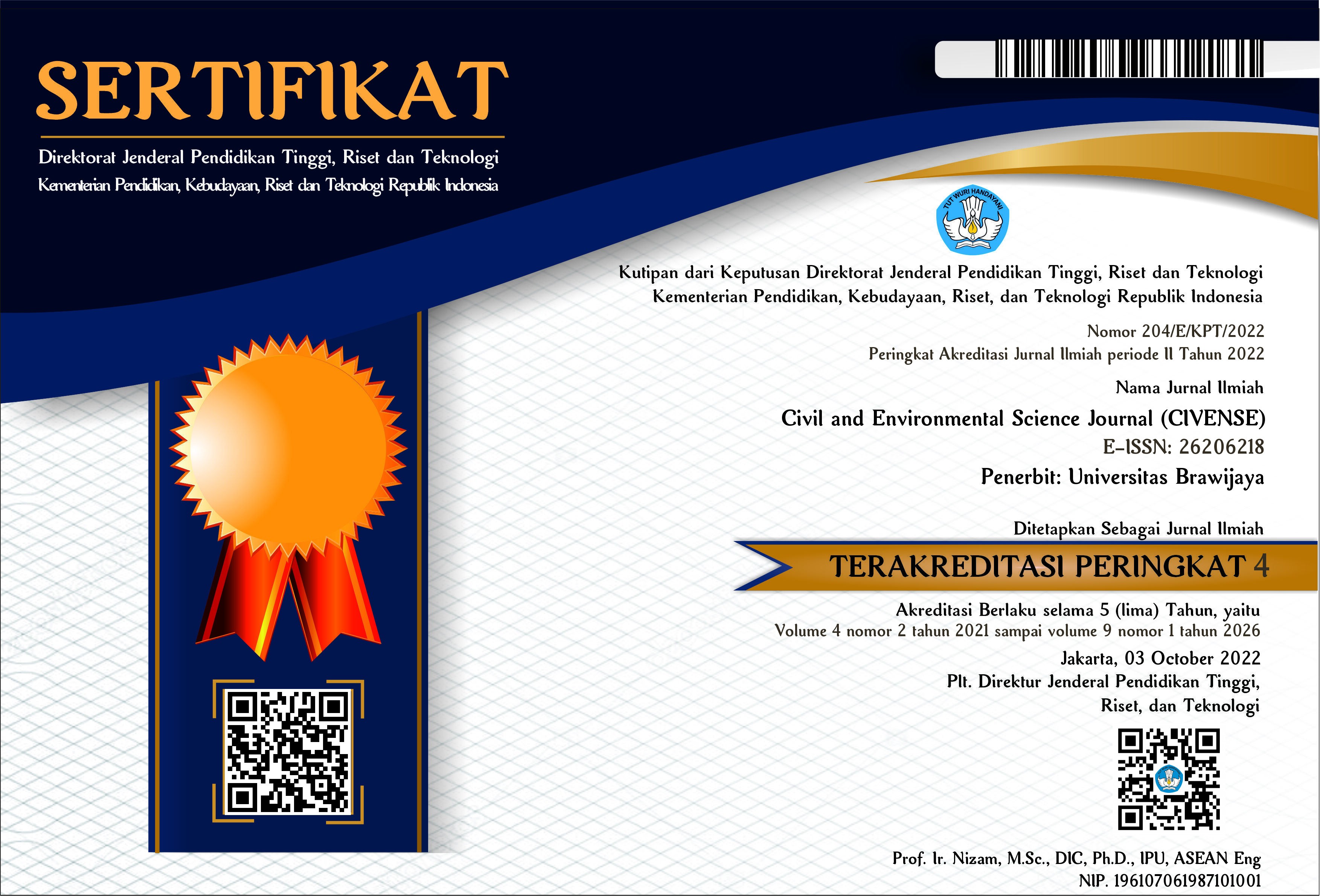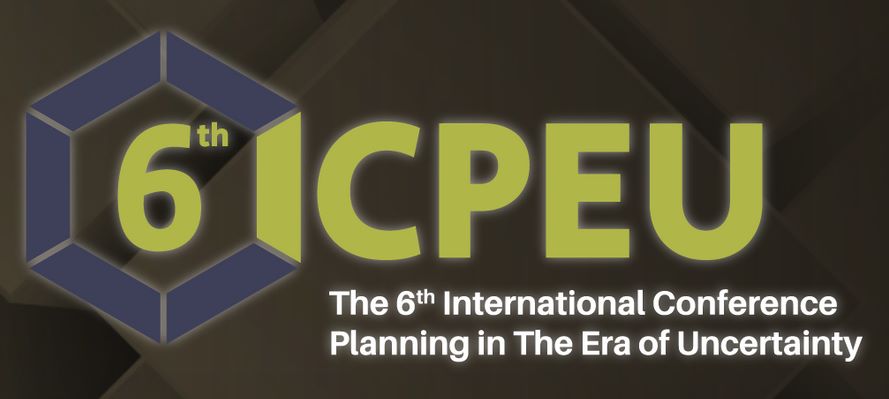Study of Tiu Kulit Dam Reservoir Operational Pattern Simulation in Sumbawa Island
DOI:
https://doi.org/10.21776/civense.v6i2.402Keywords:
Tiu Kulit Reservoir, Operation pattern, Equilibrium elevation, Inflow rates, Outflow rates, Water managementAbstract
Tiu Kulit Reservoir plays a pivotal role in managing water resources in West Nusa Tenggara, Indonesia, serving as a vital source for raw water, irrigation, and livestock consumption in the neighboring regions. This study aims to assess the operational dynamics of Tiu Kulit Reservoir across varying hydrological conditions, namely dry, normal, and wet years. The analysis is based on inflow rates and equilibrium water surface elevations. To achieve the objectives, an investigation of the reservoir's operation pattern was conducted. Inflow rates and equilibrium water surface elevations were scrutinized to discern operational behaviors under different hydrological scenarios. The findings indicate distinct operational strategies for Tiu Kulit Reservoir. During dry years, the outflow rate is restricted to 1.20 m3/s at a water surface elevation of +53.07 m. Conversely, the reservoir's operation in normal and wet years allows for a maximum outflow rate aimed at satisfying water demand, set at +57.00 m. In instances of excessive rainfall, the study highlights the potential for overflow beyond the spillway threshold. The study underscores the significance of these results for effective water management and resource allocation in the region. Understanding the reservoir's behavior under various conditions enables informed decision-making and sustainable utilization of water resources. To build upon this study, it is recommended to implement continuous monitoring systems for both inflow and outflow rates. Furthermore, the installation of rainfall monitoring stations within the catchment area would enhance data accuracy. Regular evaluations of the reservoir's operational patterns are also advised, allowing for adaptive strategies in response to evolving climate conditions. Moreover, future research endeavors should focus on augmenting water supply to meet the demands of a growing population and livestock, while optimizing agricultural practices to boost productivity.
References
L. E. Adams, J. R. Lund, P. B. Moyle, R. M. Quiñones, J. D. Herman, and T. A. O’Rear, “Environmental hedging: A theory and method for reconciling reservoir operations for downstream ecology and water supply,” Water Resour Res, vol. 53, no. 9, pp. 7816–7831, Sep. 2017, doi: 10.1002/2016WR020128.
A. Stamou et al., “Determination of environmental flows in rivers using an integrated hydrological-hydrodynamic-habitat modelling approach,” J Environ Manage, vol. 209, pp. 273–285, Mar. 2018, doi: 10.1016/j.jenvman.2017.12.038.
A. W. Tranmer et al., “Coupled reservoir-river systems: Lessons from an integrated aquatic ecosystem assessment,” J Environ Manage, vol. 260, p. 110107, Apr. 2020, doi: 10.1016/j.jenvman.2020.110107.
C. D. Killian et al., “Characterizing groundwater and surface-water interaction using hydrograph-separation techniques and groundwater-level data throughout the Mississippi Delta, USA,” Hydrogeol J, vol. 27, no. 6, pp. 2167–2179, Sep. 2019, doi: 10.1007/s10040-019-01981-6.
H. Sulistiyono, D. S. Agustawijaya, and B. W. R. Wardani, “Impacts of dams on surrounding groundwater levels,” IOP Conf Ser Earth Environ Sci, vol. 847, no. 1, p. 012001, Sep. 2021, doi: 10.1088/1755-1315/847/1/012001.
G. Palkin and I. Suvorov, “Development of a Simulation Model of the First Rise Area of a Water Supply System with a Storage Reservoir,” in 2020 International Russian Automation Conference (RusAutoCon), IEEE, Sep. 2020, pp. 804–809. doi: 10.1109/RusAutoCon49822.2020.9208073.
B. M. Ginting, D. Harlan, A. Taufik, and H. Ginting, “Optimization of reservoir operation using linear program, case study of Riam Jerawi Reservoir, Indonesia,” International Journal of River Basin Management, vol. 15, no. 2, pp. 187–198, Apr. 2017, doi: 10.1080/15715124.2017.1298604.
B. Susetyo and L. M. Rachman, “Spatial analysis model for solving clean water supply problem based on customer complaints of pdam tirta pakuan-bogor city,” vol. 19, no. 4, pp. 852–861, 2020, doi: 10.17051/ilkonline.2020.04.193.
E. Bardsley, “The Weibull distribution as an extreme value model for transformed annual maxima,” 2019.
S. Bachtiar, L. M. Limantara, Moh. Sholichin, and W. Soetopo, “Optimization of Integrated Reservoir for Supporting the Raw Water Supply,” Civil Engineering Journal, vol. 9, no. 4, pp. 860–872, Apr. 2023, doi: 10.28991/CEJ-2023-09-04-07.
E. Setyono and A. S. Rudianto, “ALTERNATIF POLA OPERASI EMBUNG SUKODONO KECAMATAN PANCENG KABUPATEN GRESIK UNTUK KEBUTUHAN AIR BAKU DAN AIR IRIGASI,” Jurnal Media Teknik Sipil, vol. 17, no. 1, Feb. 2019, doi: 10.22219/jmts.v17i1.7537.
Y. T. Ahmadi, W. Soetopo, and P. Trijuwono, “KAJIAN POLA OPERASI WADUK TUGU DENGAN INFLOW DEBIT ANDALAN DAN INFLOW DEBIT BANGKITAN AWLR,” Jurnal Teknik Pengairan, vol. 8, no. 2, pp. 205–213, Nov. 2017, doi: 10.21776/ub.pengairan.2017.008.02.6.
C. Santoso Samosir, W. Soetopo, and E. Yuliani, “OPTIMASI POLA OPERASI WADUK UNTUK MEMENUHI KEBUTUHAN ENERGI PEMBANGKIT LISTRIK TENAGA AIR (Studi Kasus Waduk Wonogiri).”
S. S. Fayaed, A. El-Shafie, and O. Jaafar, “Reservoir-system simulation and optimization techniques,” Stochastic Environmental Research and Risk Assessment, vol. 27, no. 7, pp. 1751–1772, Oct. 2013, doi: 10.1007/s00477-013-0711-4.
A. B. Celeste and M. Billib, “Evaluation of stochastic reservoir operation optimization models,” Adv Water Resour, vol. 32, no. 9, pp. 1429–1443, Sep. 2009, doi: 10.1016/j.advwatres.2009.06.008.
E. Fallah-Mehdipour, O. Bozorg Haddad, and M. A. Mariño, “Developing reservoir operational decision rule by genetic programming,” Journal of Hydroinformatics, vol. 15, no. 1, pp. 103–119, Jan. 2013, doi: 10.2166/hydro.2012.140.
M. S. Asvini and T. Amudha, “Design and development of bio-inspired framework for reservoir operation optimization,” Adv Water Resour, vol. 110, pp. 193–202, Dec. 2017, doi: 10.1016/j.advwatres.2017.10.007.
N. Ehsani, B. M. Fekete, C. J. Vörösmarty, and Z. D. Tessler, “A neutral network based general reservoir operation scheme,” Stochastic Environmental Research and Risk Assessment, vol. 30, no. 4, pp. 1151–1166, Apr. 2016, doi: 10.1007/s00477-015-1147-9.
M. S. Khorshidi, M. R. Nikoo, M. Sadegh, and B. Nematollahi, “A Multi-Objective Risk-Based Game Theoretic Approach to Reservoir Operation Policy in Potential Future Drought Condition,” Water Resources Management, vol. 33, no. 6, pp. 1999–2014, Apr. 2019, doi: 10.1007/s11269-019-02223-w.
J.-H. Song, M. S. Kang, I. Song, and S. M. Jun, “Water Balance in Irrigation Reservoirs Considering Flood Control and Irrigation Efficiency Variation,” Journal of Irrigation and Drainage Engineering, vol. 142, no. 4, Apr. 2016, doi: 10.1061/(ASCE)IR.1943-4774.0000989.
N. Ehsani, C. J. Vörösmarty, B. M. Fekete, and E. Z. Stakhiv, “Reservoir operations under climate change: Storage capacity options to mitigate risk,” J Hydrol (Amst), vol. 555, pp. 435–446, Dec. 2017, doi: 10.1016/j.jhydrol.2017.09.008.
X. Chen and F. Hossain, “Understanding Future Safety of Dams in a Changing Climate,” Bull Am Meteorol Soc, vol. 100, no. 8, pp. 1395–1404, Aug. 2019, doi: 10.1175/BAMS-D-17-0150.1.
A. Ferdowsi, S.-F. Mousavi, S. Farzin, and H. Karami, “Optimization of dam’s spillway design under climate change conditions,” Journal of Hydroinformatics, vol. 22, no. 4, pp. 916–936, Jul. 2020, doi: 10.2166/hydro.2020.019.
H. Liu, X. Yin, Z. Xu, Y. Cai, and W. Yang, “Effects of reservoir operation methods on downstream ecological disturbance and economic benefits,” River Res Appl, vol. 35, no. 7, pp. 955–965, Sep. 2019, doi: 10.1002/rra.3485.
G. F. Dourado and A. Rallings, “Assessing Hydrological Alteration Caused by Climate Change and Reservoir Operations in the San Joaquin River Basin, California”, doi: 10.3389/fenvs.2022.765426/full.
Downloads
Published
How to Cite
Issue
Section
License
Copyright (c) 2023 Yoyok Dwi Putranto, Donny Harisuseno, Tri Budi Prayogo

This work is licensed under a Creative Commons Attribution-NonCommercial 4.0 International License.
Authors who publish with this journal agree to the following terms:
Authors retain copyright and grant the journal right of first publication with the work simultaneously licensed under a Attribution-NonCommercial 4.0 International License that allows others to share the work with an acknowledgement of the work's authorship and initial publication in this journal.
Authors are able to enter into separate, additional contractual arrangements for the non-exclusive distribution of the journal's published version of the work (e.g., post it to an institutional repository or publish it in a book), with an acknowledgement of its initial publication in this journal.
Authors are permitted and encouraged to post their work online (e.g., in institutional repositories or on their website) prior to and during the submission process, as it can lead to productive exchanges, as well as earlier and greater citation of published work (See the Effect of Open Access).














